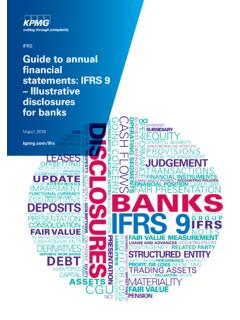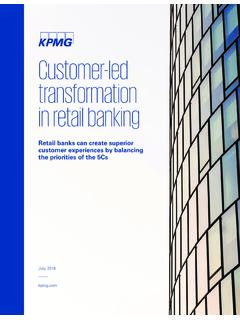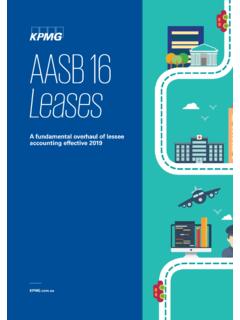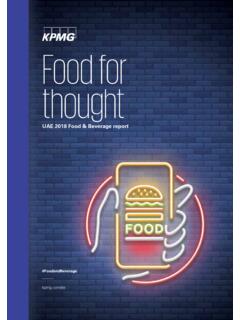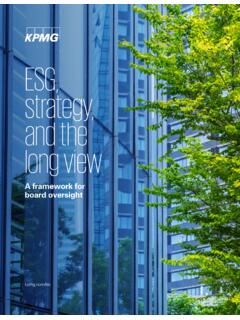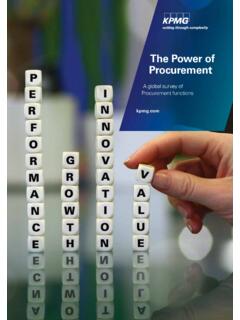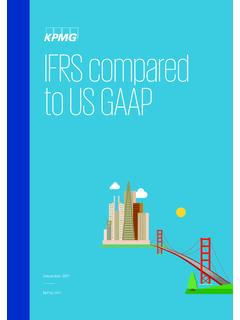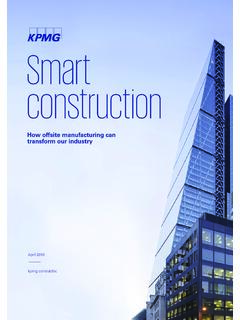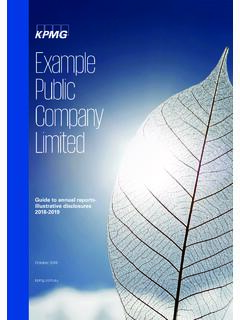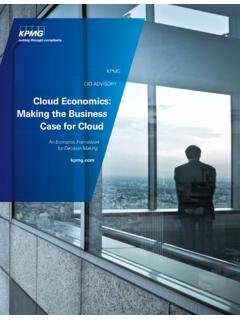Transcription of KPMG report: Summary and initial analysis of Pillar Two ...
1 KPMG report: Summary and initial analysis of Pillar Two BlueprintOctober 12, 1 2020 KPMG LLP, a Delaware limited liability partnership and a member firm of the KPMG global organization of independent member firms affiliated with KPMG International Limited, a private English company limited by guarantee. All rights reserved. The KPMG name and logo are trademarks used under license by the independent member firms of the KPMG global organization. Introduction and overview On October 12, 2020, the Organisation for Economic Co-operation and Development ( OECD ) released the Tax Challenges Arising from Digitalisation Report on the Pillar Two Blueprint (the Pillar Two Blueprint [PDF MB]). While the Pillar Two Blueprint was approved by the OECD/G20 Inclusive Framework on BEPS ( Inclusive Framework ), it does not reflect an agreement, but provides a solid basis for a future agreement.
2 The initial timeline for the work had contemplated an agreement by the end of 2020, but the Inclusive Framework s stated goal is now to bring the process to a successful conclusion by mid-2021. The Pillar Two Blueprint proposes a set of rules that attempt to ensure that large internationally operating businesses pay a minimum level of tax regardless of where they are headquartered or the jurisdictions in which they operate. The Pillar Two Blueprint proposes four new rules to accomplish this goal. The subject to tax rule ( STTR ) would apply first and would deny treaty benefits for certain deductible intragroup payments that are subject to no or low rates of nominal taxation in the recipient jurisdiction (though further consideration is being given to applying the STTR in situations beyond deductible intragroup payments). The STTR is intended to help source countries protect their tax base, especially for countries with lower administrative capacities.
3 The income inclusion rule ( IIR ) would trigger an inclusion at the level of the shareholder when the income of a controlled foreign entity is taxed at below the effective minimum tax rate. The shareholder would be subject to a top-up tax to bring the low-taxed entity s effective tax rate ( ETR ) up to the agreed minimum. The IIR is complemented by a switch-over rule ("SOR ) that allows the application of the IIR to certain branch structures when an income tax treaty otherwise obligates a contracting state to exempt the earnings of the branch. The undertaxed payment rule ( UTPR ) applies when an in-scope entity is not already subject to an IIR. The UTPR would allocate the top-up tax with respect to a low-taxed entity to other members of the group, based on deductible payments made by those other group members. The Pillar Two Blueprint defines the IIR and UTPR together as the GloBE rules in other words, the GloBE rules do not include the STTR.
4 One key issue in the Pillar Two Blueprint is how the global intangible low-taxed income ( GILTI ) regime will be coordinated with the IIR and UTPR. The Pillar Two Blueprint suggests that GILTI may be treated as a qualified IIR for purposes of the GloBE rules, which would mean that other jurisdictions would not impose the UTPR with respect to entities the earnings of which are included in GILTI. The Pillar Two Blueprint states that the Inclusive Framework recognizes that an agreement on the coexistence of GILTI and the GloBE is needed as part of a political agreement, and strongly encourages the United States to limit the operation of the base erosion and anti-abuse tax (the BEAT ) in respect of payments to entities that are subject to an IIR. KPMG observation If GILTI is treated as a qualifying IIR, the GloBE rules could still have a significant impact on groups.
5 Groups could still be subject to the UTPR with respect to their earnings in the United States (which are not included in GILTI), and payments to group members (wherever resident) could still be subject to the STTR. 2 2020 KPMG LLP, a Delaware limited liability partnership and a member firm of the KPMG global organization of independent member firms affiliated with KPMG International Limited, a private English company limited by guarantee. All rights reserved. The KPMG name and logo are trademarks used under license by the independent member firms of the KPMG global organization. As a next step, the Inclusive Framework will develop model legislation and guidance, develop a multilateral review process, and explore the use of a multilateral convention that could coordinate the implementation of Pillar Two, though the Pillar Two Blueprint argues that changes to tax treaties are not strictly necessary to implement the IIR and UTPR.
6 In a separate document (Public Consultation Document, Reports on the Pillar One and Pillar Two Blueprints), the Inclusive Framework welcomes stakeholder input on the Pillar One and Pillar Two Blueprints, and announces that it will hold a public consultation in January 2021. Written comments on the Blueprints are due Monday, December 14, 2020. Contents Introduction and overview .. 1 GloBE rules .. 3 Scope of the GloBE rules .. 3 In general .. 3 Excluded entities .. 3 Consolidated revenue threshold .. 6 GloBE ETR .. 6 Determining the amount of covered taxes .. 6 Determining the amount of income, or GloBE tax base .. 6 Jurisdictional blending .. 9 Adjustments to ETR and top-up tax .. 10 Loss carryover .. 11 Excess taxes, IIR credit, and local tax carryforward .. 11 Transfers of tax attributes .. 12 Formulaic substance-based carve-out .. 13 Calculation of ETR and top-up tax .. 14 Potential simplification measures.
7 15 CbCR ETR safe harbor .. 15 De minimis profit exclusion .. 15 ETR calculation to cover several years .. 16 Tax administrative guidance .. 16 IIR and switch-over rule .. 17 Top-down approach .. 17 Split ownership rules .. 18 Switch-over rule .. 19 UTPR .. 19 Interaction with IIR .. 19 Application to UPE jurisdiction .. 20 Allocation keys .. 20 Limitation on application UTPR to UPE 22 Mechanism to collect UTPR .. 23 Special rules for joint ventures and orphan entities .. 24 Overview .. 24 Joint 24 Orphan entities .. 24 Subject to tax rule .. 25 Connected persons .. 25 3 2020 KPMG LLP, a Delaware limited liability partnership and a member firm of the KPMG global organization of independent member firms affiliated with KPMG International Limited, a private English company limited by guarantee. All rights reserved. The KPMG name and logo are trademarks used under license by the independent member firms of the KPMG global organization.
8 Covered payments .. 26 Excluded entities .. 26 Materiality threshold .. 26 Nominal rate Test .. 27 Top-up tax .. 28 Implementation and rule coordination .. 28 Need for treaty changes .. 28 Mechanisms for coordination of the GloBE rules .. 29 Dispute prevention and resolution .. 29 GloBE rules Scope of the GloBE rules In general Under the Pillar Two Blueprint, the GloBE rules generally would apply to MNE Groups and their Constituent Entities that are subject to Country by Country Reporting ( CbCR ) specifically, groups of entities (including permanent establishments) that are required to prepare consolidated financial statements for financial reporting purposes (or would be so required if the interests in any of the enterprises were publicly traded) and that have annual revenue of more than 750 million. However, certain Ultimate Parent Entities ( UPEs ) that typically benefit from an exclusion or an exemption from tax under the laws of the jurisdiction where they are incorporated are excluded ( Excluded Entities ).
9 The Pillar Two Blueprint states that further consideration will be given to cases in which the exclusion arguably should still apply in respect of a Constituent Entity that is not otherwise the UPE, such as certain life insurance and pension structures that are consolidated within an MNE Group and whose income is not beneficially owned by the MNE Group. Excluded entities The UPEs that qualify as Excluded Entities are investment funds, pension funds, governmental entities (including sovereign wealth funds), and international and non-profit organizations. An investment fund for this purpose means an entity or arrangement that meets several criteria, including: (a) it is designed to pool assets from an Excluded Entity or a number of investors (at least some of which are not connected); (b) it invests in accordance with a defined investment policy and/or to reduce transaction costs and research and analytical costs and/or to spread risk collectively; (c) the fund, or the management of the fund, is subject to the regulatory regime for investment funds in the jurisdiction in which it is established or managed (including appropriate anti-money laundering and investor protection regulation); and (d) it is managed by fund management professionals on behalf of the investors.
10 An investment fund also includes an entity that is wholly owned or almost exclusively owned by one or more investment funds or other Excluded Entities, that does not carry on a trade or business, and that is established almost exclusively to hold assets or invest funds for the investment fund or Excluded Entities. KPMG observation A fund of one can meet the definition of an investment fund, as long as the investor is an 4 2020 KPMG LLP, a Delaware limited liability partnership and a member firm of the KPMG global organization of independent member firms affiliated with KPMG International Limited, a private English company limited by guarantee. All rights reserved. The KPMG name and logo are trademarks used under license by the independent member firms of the KPMG global organization. Excluded Entity. In other cases, the investment fund must pool assets from more than one unrelated investor.
